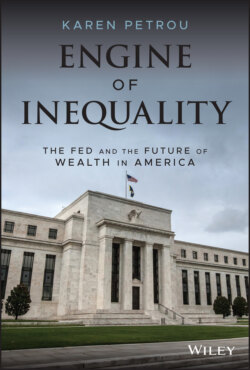Читать книгу Engine of Inequality - Karen Petrou - Страница 23
The Most Inclusive Ever?
ОглавлениеHaving addressed President Trump's assertion that America now is awash with shared income and wealth that knows neither race nor color, let's see if the US is, as he also says, the most inclusive in the world.
In the most recent global-equality analysis,45 the Middle East was again the most unequal part of the world due to decades of tribal and similar wealth-distribution practices. Russia and China interestingly became strikingly more unequal as their communist past has faded into capitalist-oligopolistic wealth distribution. In Russia, the ratio between private wealth and national income grew three times as the state economic regime changed; in China, this ratio actually quadrupled even though overall wages in China also grew dramatically for lower-income workers.46 Although overall global inequality has gone down slightly, the very top of the income distribution in emerging economies still receives far more of growing national income than most of the rest of the population. In many nations, the very top and the lowest income groups gained share, but what was once the middle class is as hollowed out as that in the US.
From the US perspective, the most interesting aspect of the global data is the divergence between Western Europe and the US. Although both were about equal from 1950 to 1980, the income divide has grown dramatically and differently ever since.47 As Figure 2.1 shows, in 1980, the top 1 percent in both regions controlled about 10 percent of income. By the latest data from 2016, the 1 percent's share in Western Europe was 12 percent. In the US, it was 20 percent.
Look below the numbers and it's even clearer how much of a difference policy decisions make to equality results. Western European nations are institutionally structured to ensure equality to the greatest extent possible through higher taxes, universal health care, inexpensive higher education, and generous state retirement benefits – just to mention a few equality-policy distinctions. Critics counter that these same policies constrain growth and, in the most recent period, innovation. However, US economic growth was at best lackluster before COVID and the “full” employment about which the Fed was wont to brag was in fact far less impressive when labor-participation rates and other factors are carefully considered.
Figure 2.1 Diverging Income Inequality: Changes to Income Distribution 1980-2016, U.S. vs. Western Europe
Source: WID.world (2017).
Labor-participation rates measure not who has a job, but who wants a full-time job but has yet to find one. This rate has declined over the past twenty years, a sharp contrast to other industrialized nations in which men and women between 25 and 54 steadily joined the workforce.48 Also, having a job is no guarantee that the job is good enough to ensure household sustenance – in late 2019, nearly one in five Americans had a job but still wanted and many also needed to work more to make ends meet.49
All told, Western Europe remains more equal than the US even if one gives the US the benefit of the doubt due to somewhat greater growth and employment since the great financial crisis and overlooks the enormous macroeconomic cost of COVID that reversed all these gains in as little as two weeks. And, no matter all the cost to high-income households of all its equality and social mobility, Sweden still had more billionaires as a percentage of its population than the US.50
